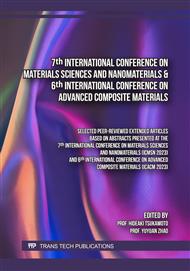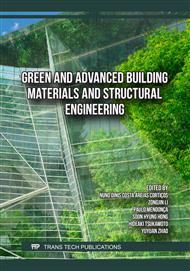[1]
E.G. Nawy: Prestressed concreate: a fundamental approach (Prentice Hall, New York 2009)
Google Scholar
[2]
M.G. Mangala and B. Haym: Dynamic response of an axially loaded tendon of a tension leg platform. J. Sound Vib. Vol. 293 (2006) p.38.
DOI: 10.1016/j.jsv.2005.09.027
Google Scholar
[3]
Y. Zhao, J. Yang and Y. He: Preliminary design of a multi-column TLP foundation for a 5-MW offshore wind turbine. Energies Vol. 5 (2012) p.3874.
DOI: 10.3390/en5103874
Google Scholar
[4]
V. Périer, L. Dieng, L. Gaillet, C. Tessier, and S. Fouvry: Fretting-fatigue behaviour of bridge engineering cables in a solution of sodium chloride. Wear Vol. 267 (2009) p.308.
DOI: 10.1016/j.wear.2008.12.107
Google Scholar
[5]
U. Meier: Carbon fiber reinforced polymer cables: Why? Why Not? What If? Arab. J. Sci. Eng. Vol. 37 (2012) p.399.
DOI: 10.1007/s13369-012-0185-6
Google Scholar
[6]
Komatsu Matere fabric laboratory [fa-bo] on https://www.komatsumatere.co.jp/.
Google Scholar
[7]
Nagase ChemteX Corporation. Process for production of thermoplastic cured epoxy resin with transparency to visible light, and thermoplastic epoxy resin composition. U.S. Patent No. US2014/0194590 A1 (2014).
Google Scholar
[8]
K. Naito and H. Oguma: Tensile properties of novel carbon/glass hybrid thermoplastic composite rods. Compos. Struct. Vol. 161 (2017) p.23.
DOI: 10.1016/j.compstruct.2016.11.042
Google Scholar
[9]
K. Naito, H. Oguma and C. Nagai: Temperature-dependent tensile properties of hybrid carbon/glass thermoplastic composite rods. Polym. Compos. Vol. 41 (2020) p.3985.
DOI: 10.1002/pc.25686
Google Scholar
[10]
K. Naito: Flexural properties of carbon/glass hybrid thermoplastic epoxy composite rods under static and fatigue loadings. Appl. Compos. Mater. Vol. 28 (2021) p.753.
DOI: 10.1007/s10443-021-09893-z
Google Scholar
[11]
H. Oguma and K. Naito: Hybridization effects on the fatigue properties of novel core-in-sheath-type carbon/glass hybrid thermoplastic composite rods. Fatigue Fract. Eng. Mater. Struct. Vol. 45 (2022) p.3514.
DOI: 10.1111/ffe.13826
Google Scholar
[12]
K. Naito, H. Oguma, J. Tanks and C. Nagai: Reliability evaluation of novel core-in-sheath-type carbon/glass hybrid thermoplastic composite rods. Mater. syst. Vol. 40 (2023) p.37.
Google Scholar
[13]
J. Tanks, K. Naito and H. Ueda: Characterization of the static, creep, and fatigue tensile behavior of basalt fiber/polypropylene composite rods for passive concrete reinforcement. Polymers Vol. 13 (2021) p.3136.
DOI: 10.3390/polym13183136
Google Scholar
[14]
E.A. Turi: Thermal Characterization of Polymeric Materials (Academic Press, New York 1997).
Google Scholar
[15]
W. Weibull: A statistical distribution function of wide applicability. J. Appl. Mech. Vol. 18 (1951) p.293.
Google Scholar
[16]
K. Naito, Y. Tanaka, J.M. Yang and Y. Kagawa: Tensile properties of ultrahigh strength PAN-based, ultrahigh modulus pitch-based and high ductility pitch-based carbon fibers. Carbon Vol. 46 (2008) p.189.
DOI: 10.1016/j.carbon.2007.11.001
Google Scholar
[17]
K. Naito, J.M. Yang and Y. Kagawa: Tensile properties of high strength polyacrylonitrile (PAN)-based and high modulus pitch-based hybrid carbon fibers-reinforced epoxy matrix composite. J. Mater. Sci. Vol. 47 (2012) p.2743.
DOI: 10.1007/s10853-011-6101-8
Google Scholar
[18]
Y. Qiu and P. Schwartz: Micromechanical behavior of Kevlar-149/S-glass hybrid seven-fiber microcomposites: I. Tensile strength of the hybrid composite. Compos. Sci. Technol. Vol. 47 (1993) p.289.
DOI: 10.1016/0266-3538(93)90037-h
Google Scholar
[19]
B. Harris: Fatigue in Composites (Woodhead Publishing, Cambridge 2003).
Google Scholar
[20]
I. Kafodya, G. Xian and H. Li: Durability study of pultruded CFRP plates immersed in water and seawater under sustained bending: Water uptake and effects on the mechanical properties. Compos. Part B. Eng. Vol. 70 (2015) p.138.
DOI: 10.1016/j.compositesb.2014.10.034
Google Scholar



